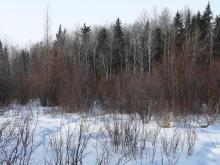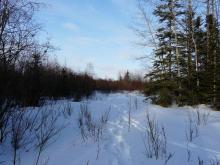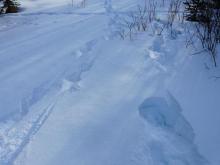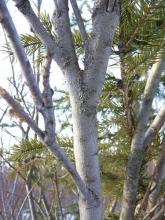We were talking about fall fruiting Salix the other day; yesterday I went out into the area just beyond my acreage, on my uncle's farm; there is a large wetland area of grasses, sedges and mixed open brush/woodland (in every gradation and combination) which snakes its way in patches and stretches between more mesic mixed/coniferious woods..
I was looking at first for early pussywillows, which sometimes pop out (still far from flowering) in late winter; none seen, but I did see remaining seedpods on fall fruiting Salix/Willows (along with presumed Betula and animal tracks; full album on Picasa:
https://picasaweb.google.com/cactuscactus/February232011WinterWillowsAnd... )
first a couple views of some older willows just at the back of my acreage, in a damp to wet wooded area on the North side of a mixed/coniferous stand.. this is about as large as I have seen willows get here--at a guess around 30feet/10m; they tend to lean on other trees and/or need fairly dense clumps to support themselves at this height, and even still, many older trunks die partly or completely and fall partl or completely dead or alive; I have been gradually clearing out this area, harvesting dead/fallen trunks for firewood, making the area more passable and opening up the ground level to species wanting a bit more light (just past this, I am leaving the next strip tangled for plants and animals that prefer that habitat)
Many wildflowers thrive in this zone, from the conspicuous Caltha palustris, just a bit later in shady places like this, to Geum rivale-lush foliage and floppy flower stems, Lysimachia thyrsiflora, un-flashy Platantheras, to Maianthemum trifolium in wet shady places, tiny Viola renifolia at the edge of the regular woods, etc... No sign of any of that at this time! All under knee deep snow...
not rockgarden Salix/Willows
Forums:

Comments
cohan (not verified)
Re: not rockgarden Salix/Willows
Thu, 02/24/2011 - 1:31pmOut onto the farm; these woody wetland areas are periodically cleared by bulldozer to restore grazing area-typically a decade or several between clearings; its been some time now...



The emptier space between the willows and the regular forest is likely due to this being a more popular route for cattle when they are pastured here--they tend to choose these edges as less wet than farther out, more grassy than the forest, and regular passage tends to keep all vegetative growth more pruned, depending on how many cattle, how often! If the area had been heavily grazed over the last couple of decades, the willows themselves would not have grown up to this extent..
Wildlife also plays a significant role in plant development, moose, in particular, spend a lot of time in these wet shrubby areas, and many Salix and Betula (among numerous native species) have a high percentage of branch tips nipped off.. rabbits are also common, as are coyotes, deer, etc; Interestingly, few of these animals are seen, but their tracks and poops are common!
cohan (not verified)
Re: not rockgarden Salix/Willows
Thu, 02/24/2011 - 1:41pmScattered among the other species which fruit in spring/summer, the occasional Salix/Willow which fruits in fall still bears its seedpods, visible from a distance.
the last image shows a trunk; these are multi-stemmed shrubs/ small trees to at least several metres; in the garden these could be easily pruned to shape, or sheared to the ground every few years if you needed them small; I like them with a bit of age, though, and the seeds add visual appeal in winter!!

cohan (not verified)
Re: not rockgarden Salix/Willows
Thu, 02/24/2011 - 1:47pmA last few willow shots, just to give a hint of the diversity of species growing together, here are shots of several dried leaves, growing within a fw metres or less of one another;
The first , I think! is from the fall fruiting plant....
cohan (not verified)
Re: not rockgarden Salix/Willows
Thu, 02/24/2011 - 1:58pmI was going to do a second topic for the Birches, but decided to keep them here for consistency--all the habitat information still applies!
Perhaps a moderator can change the topic name to be more appropriate?
I have yet to definitively decide what species we have locally in terms of dwarf birch/betula, or even be sure which are birch and which the closely related Alder/Alnus! Must pay closer attention over the season! Flowers and fruits in particular I have not separated..
Based on small roundish leaves, I think these are birches, and I think the sp or spp we have are all to several metres tall--smaller plants are seen, but I assume they are young and/or have been eaten!
First two images from a plant over 2 m tall..
next two are a very small plant, but being at the edge of the wooded area, it is more tempting to passing browsers
last two images are another taller plant, showing the bark and buds
Lori S. (not verified)
Re: not rockgarden Salix/Willows
Thu, 02/24/2011 - 9:09pmSomeone please correct me (always!) if I am wrong, but photos 1 through 4 in the set directly above this appear to be alders, and photo #4 appears to be speckled alder (Alnus rugosa).
cohan (not verified)
Re: not rockgarden Salix/Willows
Thu, 02/24/2011 - 11:15pmSee--told you I haven't figured these out ;) I'll send photos with leaves once they come, and try to catch spring catkins.. I think I need to come up with some system with strings or tags or something to try to keep track of some of these and willows through the seasons to get a better sense of what is what--it's very hard to look at all the characters which occur in different seasons when I can't say if I am looking at the same plant among many acres of similar plants!...lol
A 4-10cm leaf length (which is what I see for a couple of Alnus) seems much larger than the leaves on anything in the area/land type where I was photographing, but again, can't say for sure about that particular plant.. I have seen a few shrubs/trees on other parts of the farm--not in the wetter willow zones--that had larger leaves and I thought must be Alders.... These shrubs/small trees growing with Salix/willow, black spruce/Picea mariana and tamarack/Larix laricina seem generally to have small leaves, though I'm sure some have the more 'channeled' look of Alnus;
Checking Flora of Alberta, I see they only list A crispa and A tenuifolia, which they mention as being 'closely related to the eastern A rugosa'
Again, tenuifolia seems to have larger leaves than I recall in these wet areas (but I will measure some, in season); crispa seems possible, with leaves 2-8 cm, the smaller end of that being what I recall (many leaves even less than 2cm, maybe those are the birches); both of these Alnus species are likely in my area based on the maps...
Lori S. (not verified)
Re: not rockgarden Salix/Willows
Fri, 02/25/2011 - 7:28pmAlders can be distinguished from birches in winter by the persistent cones on alders; the cones on birches disintegrate through the late summer/fall (assisted by flocks of siskins feeding on the seeds, in the case of the birches in our yard).
Yes, I was misled by another book which equates Alnus rugosa, A. tenuifolia and A. incana spp. tenuifolia... which doesn't seem to be the popular view. I thought I detected yellow-brown bark with prominent raised pores in photo #4, which is said in this book to be distinctive.
Richard T. Rodich
Re: not rockgarden Salix/Willows
Fri, 02/25/2011 - 8:20pmI actually thought the same as you, Lori, but alders here could be very different from ones there so I'm really not qualified. The lenticels and branch configuration look very alder like to me.
But then I was kinda thrown off too, because I assumed all alders had these kind of "cones", but I guess not. (At least, all the ones native here do.)
http://www.missouriplants.com/Catkins/Alnus_serrulata_cones.jpg
cohan (not verified)
Re: not rockgarden Salix/Willows
Fri, 02/25/2011 - 11:20pmThanks Lori and Rick: I will need to find some system of tagging as I mentioned, so I can be sure of photographing the same plants on various occasions.. I have no doubt there are alders in the mix out there, just nothing (that I remember- I'll be measuring this year!) with leaves anywhere near 4cm long, nevermind 8-10!..
Based on your comments on cones, the first two photos in the second set show a plant with persistent cones similar to those in Rick's link..
the second two photos, of the smaller plant, show a different sort of structure--there were seed heads there in plenty, but they disintegrated at a touch, so this one must be a birch..
the last two shots are yet another plant, don't recall whether it had any fruiting structures--may take another look on next day off--I can probably refind those three plants at this point based on my tracks in the snow...lol
Lori--seems there is some disagreement about names--I quoted Moss/Packer, but Royer/Dickinson had those same species listed as subspecies and another book uses rugosa, seemingly as synonymous with tenuifolia; close enough for me, with these, if I can get a species, I wont sweat the synonymy too much
Trond Hoy
Re: not rockgarden Salix/Willows
Sat, 02/26/2011 - 2:41amYou have too many different plants of all kinds in your area, Cohan! Here it is no problem differentiating Alnus and Betula (two species of Alnus (both trees) and three species of Betula (2 trees and one shrub and some common hybrids between these).
Salix is a different matter. Scores of species and hybrids too!
Lori S. (not verified)
Re: not rockgarden Salix/Willows
Sat, 02/26/2011 - 10:10amWe only have 2 alders here, the ones Cohan mentioned, and they both have persistent cones unlike birches. Very impressive, Rick - I need to learn to distinguish more trees/shrubs on the less obvious characteristics... thankfully, we don't have all that many species to distinguish! (Excepting the plethora of willows...)
Trond, our diversity of alders and birches (4 possible species in this area) isn't a whole lot greater than yours!
cohan (not verified)
Re: not rockgarden Salix/Willows
Sat, 02/26/2011 - 10:27amAs Lori said, not so many species of trees/treeish shrubs here! Just my greenness at looking at them makes any confusion--and the fact that in the kind of habitat I am looking at, almost everything is bushy multistemmed shrub with smallish leaves!
Nice to think of my area as having an overabundance of species (not bad, I think bordering a couple of different biomes helps, and the often non-intensive nature of local agriculture), but its not really true, just an underabundance of knowledge :-[